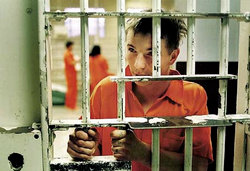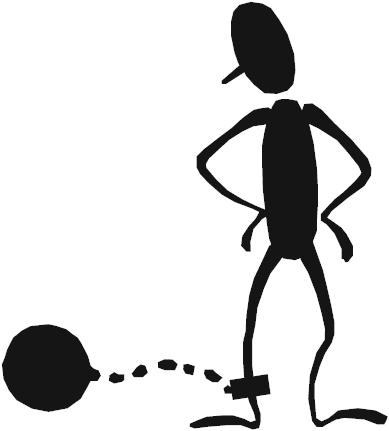
Providing an Optimal Education
to Youth in Correctional Settings

The only time that most of us find ourselves in jail is when we play Monopoly.
However, some of us choose to teach in correctional settings for youth. This page is dedicated to them.

“Education is the fundamental way to prevent incarceration.” (Bonita Parker)
Below you will find the links to a video round-table discussion in which Dr. Mac joins two colleaues to talk about optimal education practices for youth in correctional settings (detention centers, prison).
__________________________________________________________________________
Our session begins by meeting a couple of our students…
It was the last straw for the juvenile court's Judge Hossenfeffer to whom Leon’s face was as familiar as the corn muffin with syrup she ate each morning for breakfast. After a slew of appearances for petty theft, assault, and misdemeanor drug use, the gavel came down on a 3-month sentence at the local youth detention facility. Leon’s latest heinous act was caught on video: While he and three friends walked toward a teacher, Leon moved behind the group to jump out and “cole-cock” (surprise punch) the teacher who would then spend two days in the hospital for treatment of his concussion before multiple visits to the dental surgeon, and the beginning of counseling sessions for Post Traumatic Stress Disorder.
As a condition of his release and probation from “juvie hall” (youth detention facility), Leon was directed to attend a special class for students with behavior disorders in a different school from his previous one. His disruptive and threatening behavior continued at a pronounced level in that setting, earning him a transfer to an alternative school designed to serve students with severe mental health and behavioral needs.
Despite the supportive and structured setting that was staffed with caring and competent faculty and staff, history is now repeating itself therein.
Leon’s behavioral history is most likely tied to his personal life history. His mother suffers from bouts of deep life-halting depression. She self-medicates with alcohol and a combination of prescription and illicit drugs. There are many men who come in and out of Leon’s life for varying periods of time, but he rarely sees his biological father. Those rare times come on holiday visits to an upstate prison where his dad is serving 17 to 20 years for a robbery gone wrong… one that left the cashier physically disabled.
Leon has been known to school administration, mental health services, and child protection agencies since he was 9 years old. He has been in and out of special classes, alternative schools, a residential treatment center, and, as you read, juvie hall. He seems to possess immunity to treatment plans, and justifies his actions as necessary responses to perceived insults.
His faculty and staff in the detention facility know the sobering startistics: ½ to ¾ of minors who spend time in juvenile detention facilities are incarcerated again.
.
______________________________________________________________________________
Chantal steps down from the small school bus and shouts an obscenity (accompanied by a middle finger salute) at the driver. She storms up the steps and through the door, followed by a staff member who attempts to stop her. She swings her arm wide, but it is caught mid-assault by the trained staff member who uses Chantal’s momentum to steer her to the floor. While being restrained, she screams out claims of being fondled by the male crisis team members. Here identification of body parts are not stated in scientific terms. Students peek out the doorways, and ooze into the hallway, gathering to witness the not-uncommon scenario. Some shout support for Chantal. Others egg her on. Faculty members and office personnel shoo the kids back to their homerooms.
After a debriefing session with the school psychologist, Chantal enters her classroom, hood over her bowed head, and pushes another student out of the aisle that leads to her seat. Once seated, Chantal lowers her scrowled face into her folded arms and is unresponsive to the teacher’s attempt to engage her.
The frustrated teacher strikes out with words that would be near-acceptable if written on paper, but drip with negative feelings in the oral version: “Having another bad day today, are we Chantal? Do you need to go back to your counselor for a little more hand-holding?”
Chantal’s reply is to spit out a venomous “F… U!” (not “funny underwear” or a reference to an institution of higher learning) as she exits the classroom in an enraged behavioral malstrom.
It takes a while for the teacher to settle the emotionally turmoil, and shakily resume the lesson.
__________________________________________________________________________________
 Chantal and Leon are representative of our kids who have strayed furthest from the dream. They have fallen to such depths that society feels the need to segregate and lock them away from us. While they are the kids in greatest need, they are the most neglected and despised.
Chantal and Leon are representative of our kids who have strayed furthest from the dream. They have fallen to such depths that society feels the need to segregate and lock them away from us. While they are the kids in greatest need, they are the most neglected and despised.
They are the youngsters with conduct disorders at the tier 3+ level. They’re not simply located in Tier 3 of the PBIS model… they are perched at Tier 3.99… perhaps having created a Tier 4. They plant their behavioral flag on the pinnacle of the PBIS triangle. (or pyramid if you mix it with RtI)
Having violated the legal and societal code of conduct with verousity, they have been the recipients of the most severe disciplinary penalties. Yet they still outrightly refuse to change their wrongful ways. What then are we educators and their professional colleagues to do? How do we use their times away from the mainstream educational environments to prepare them to re-enter?
The answers can be found in today's video and accompanying material, and the follow ups that will arrive on subsequent Sundays.
While we initially mention the New York City system, after the first minute you'll see the universal application of the material. Now, please join Drs. Lisante, Barowsky, and McIntyre as they provide guidance in reaching and teaching students in youth correctional facilities...
Click on the image to start the video
22 minutes in length
If the video take too long to develop, watch it in parts:
___________________________
How do we motivate the unmotivated? How do we convince these misdirected junior citizens that their errant actions are placing them at great risk for life failure? How do we move them from a “Get lost! Leave me alone.” attitude to one that is enthusiastic about working with us toward the display of more appropriate actions?
Those questions are the same ones that have kept me up nights for the last two years, working on a motivational assessment and intervention package. NOW it’s ready and I present it proudly to you…. The Behavior Transformation Guide (BTG).
As a former teacher of kids labeled as being severely behavior disordered (They were labeled correctly!), I look back with pride on the time we spent together and the positive changes they came to show. As a Ph.D. holder in the education of emotionally and behaviorally disordered kids, I’ve been able to look at things from another angle. That binocular focus has allowed me to create the BTG… something that I wish we had in our busy little hands in in the various facilities in which I taught.
Now, we who care about these kids, have an assessment instrument that is based in research and reality; one that identifies the present stage of “readiness for change”. Depending on which stage is identified, a listing of prescribed intervention strategies is provided. (Many of them are hyper-linked to how-to-do-it descriptions of the multi-step procedures.) The strategies on the lists are designed to move the youngster to higher stages of willingness to work cooperatively with us on positive behavior change (or maintain that progress when they are experiencing success).
__________
Steer your intervention-resistant youngsters to better life choices.
Click on the Behavior Transformation Guide in order to learn more about it.
The binder image visually represents what you will receive electronically & how you might wish to store any printouts.
Upon purchase, the BTG is delivered immediately to your e-mail inbox in PDF form.
The electronic format allows you to make modifications for the particular circumstances of your setting before printing.
It also allows you to access hyperlinks to how-to-do-it web pages for the indicated intervention strategies.
AND... Never buy more assessment instruments. Just print another! It's another HUGE savings.
The BTG is a 67 page packet contains:
1. An overview of the Readiness for Change Model ...... READ IT NOW! (free)
2. Procedures for administering the assessment instruments
3. The Behavioral Assessment of Readiness for Change (BARC) (Completed by Adults)
4. The Ready Report (Completed by the youngster)
5. Tailored Lists of Behavior Change Interventions for Each Stage (For moving the youngster to higher levels of readiness for change)
Read more about the BTG at: www.BehaviorAdvisor.com/ReadinessForChange.html
The Behavior Transformation Guide!
Familiar with the "Circle of Courage" model?
If so, find out about 2 new assessment devices.
If not, check your "B-list" mailing next week.
![]()
Pup, I think they're ready to change ... pages.
| Return to the "Intervention Strategies" index |

| Return to the BehaviorAdvisor.com home page |
Author: Tom McIntyre, Ph.D. DoctorMac@BehaviorAdvisor.com